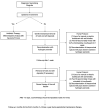The Management of Necrotizing Gingivitis in Paediatric Patients: A Scoping Review and Two Case Reports
- PMID: 39201953
- PMCID: PMC11353011
- DOI: 10.3390/children11081019
The Management of Necrotizing Gingivitis in Paediatric Patients: A Scoping Review and Two Case Reports
Abstract
Necrotizing gingivitis (NG) is an acute inflammatory process with an estimated prevalence of less than 1%. The treatment of choice is usually antibiotics in addition to periodontal treatment. This scoping review aims to detail extent and type of proof related to NG in paediatric patient; moreover, a decision tree protocol was developed to define NG management in paediatric patients based on the presence or absence of systemic compromission. In addition, we also propose the use of ozone treatment as an adjuvant therapy. Seven papers (3 case reports, 2 guidelines, and 2 reviews) were selected for evaluation by reading the full texts. This review outlines the lack of research on the treatment of NG in paediatric patients; we, however, demonstrate the efficacy of the decision tree protocol by describing two case reports in which patients were treated with antibiotics according to the presence or absence of systemic involvement through the implementation of an individualized therapeutic approach, with periodontal ozone therapy. Moreover, the supportive use of this molecule in the management of NG can be a valuable tool in the healing of gingival tissues.
Keywords: antibiotic; necrotizing gingivitis; ozone; ozone therapy; paediatric.
Conflict of interest statement
The authors declare no conflicts of interest.
Figures

















References
-
- Papapanou P.N., Sanz M., Buduneli N., Dietrich T., Feres M., Fine D.H., Flemmig T.F., Garcia R., Giannobile W.V., Graziani F., et al. Periodontitis: Consensus report of workgroup 2 of the 2017 World Workshop on the Classification of Periodontal and Peri-Implant Diseases and Conditions. J. Periodontol. 2018;89((Suppl. 1)):S173–S182. - PubMed
-
- Eley B.M., Soory M., Manson J.D. Chapter 25: Acutenecrotising ulcerative gingivitis. In: Eley B.M., Soory M., Manson J.D., editors. Periodontics. 6th ed. Saunders; Edinburgh, UK: Elsevier; New York, NY, USA: 2010. pp. 376–379.
-
- Dufty J., Gkranias N., Donos N. Necrotising Ulcerative Gingivitis: A Literature Review. Oral Health Prev. Dent. 2017;15:321–327. - PubMed
Publication types
LinkOut - more resources
Full Text Sources

